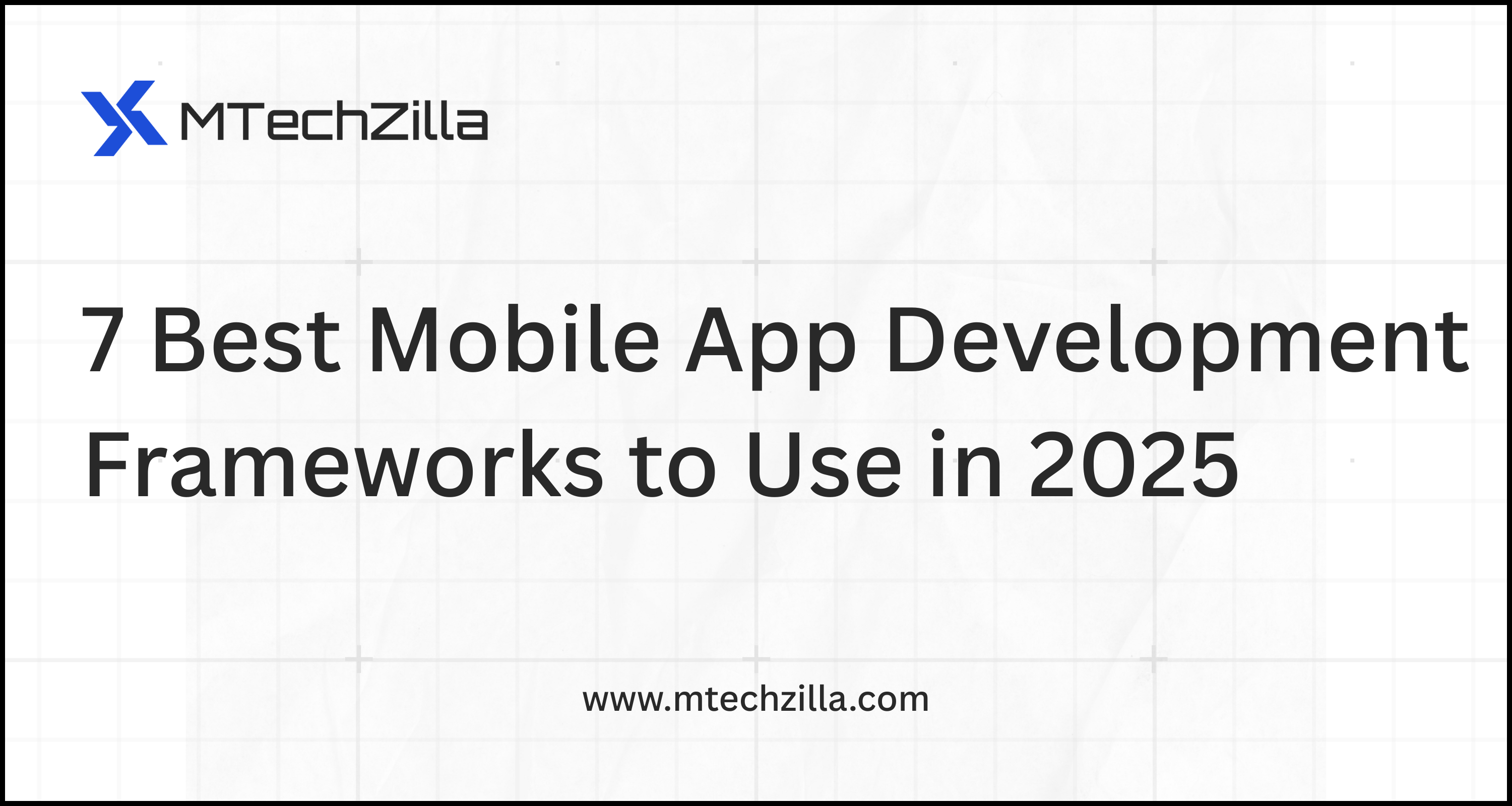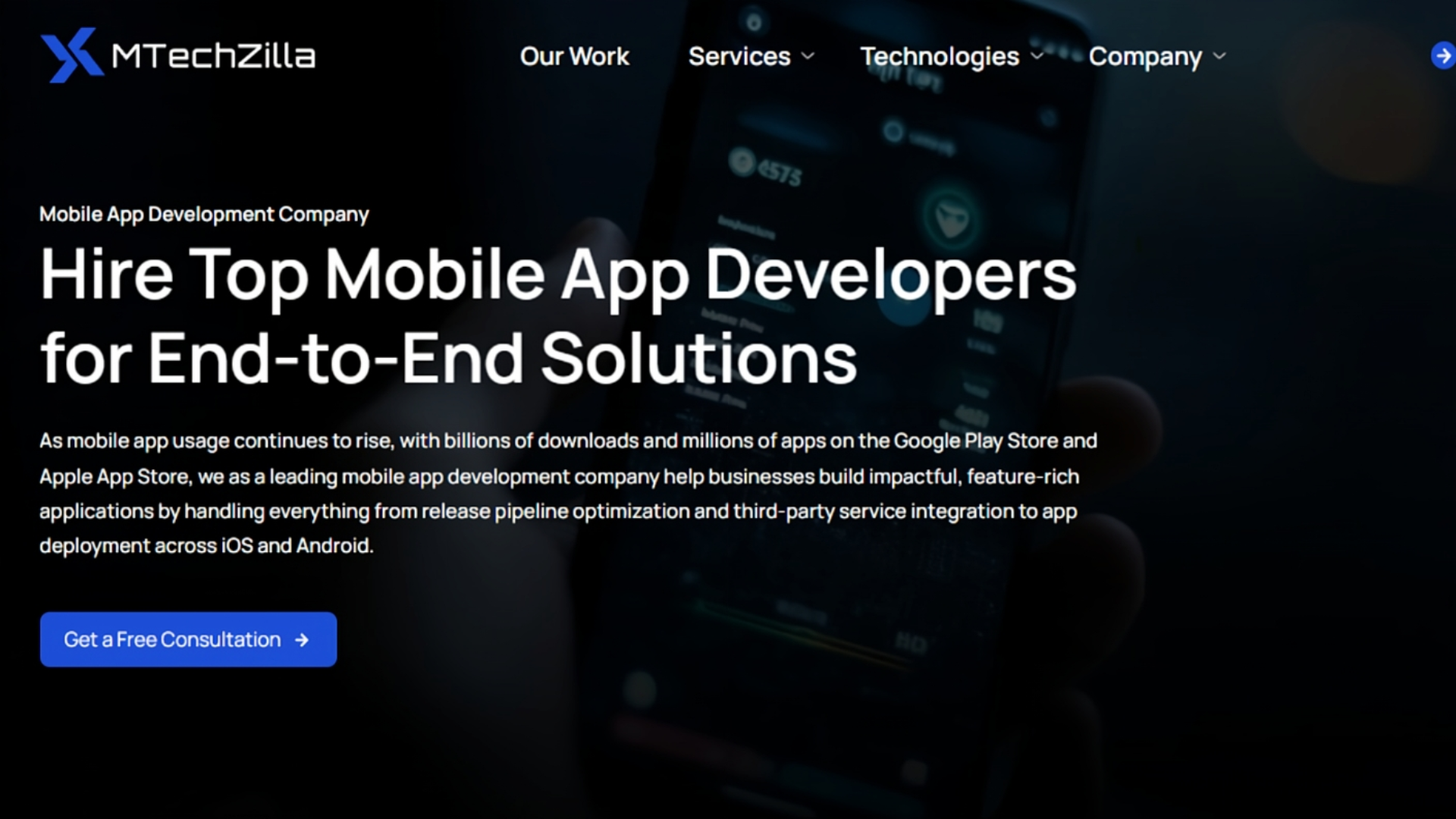August 19, 2025
15 min read

If you’re a developer, tech lead, or CTO looking to build a mobile app in 2025, you’re probably asking yourself a lot of questions right now:
Which framework will let our team build apps faster without compromising quality?
Will this framework handle complex features, or are there skill limitations in our team?
How do we prioritise features and projects while keeping up with tech trends?
Can cross-platform frameworks now deliver the performance, flexibility, and device access we need, or is native development still the safest choice for complex apps?
These are exactly the thoughts we considered before creating this list. In this article, we’ve combined market research, trend analysis, developer feedback, and real-world project insights to give you honest guidance.
Each framework we cover is analyzed from a developer’s perspective: how easy it is to use, what challenges we might face, and where it truly shines in a modern project. By the end, we’ll have a practical roadmap for choosing a framework that aligns with our team’s skills, project requirements, and future growth.
Let’s break down the 7 top mobile app development frameworks for 2025 and help us make an informed, confident decision for our next app.
Introduction
What is a Mobile App Development Framework?
Types of Mobile App Development Frameworks
7 Best Mobile App Development Frameworks
Quick Takeaways of the 7 Best Mobile App Development Frameworks
How to Choose the Best Mobile App Development Framework for Your Project
FAQs
A mobile app development framework is a structured set of tools, libraries, and components that provides developers with everything they need to design, build, and maintain mobile apps efficiently for iOS, Android, or both without starting from scratch.
It provides the structure, reusable code, and ready-made components we need. Typically, a framework includes:
Pre-built UI components such as buttons, forms, and navigation menus
APIs and libraries to access device features like the camera, GPS, or push notifications
Code structure and project templates to organize the app logically and maintainably
Tools for testing, debugging, and deploying apps more efficiently
Usually, mobile application frameworks fall into three main categories: native frameworks, cross-platform frameworks, and hybrid frameworks. These categories are based on how apps are built, the platforms they target, and the type of code they use.
Understanding these categories helps developers and teams decide which framework is best for a particular project, whether the focus is on performance, development speed, or cross-platform compatibility.
Key Features:
Built specifically for one platform (iOS or Android)
High performance and smooth animations
Full access to device features like camera, GPS, and sensors
Platform-specific UI/UX consistency
Specifically for: Apps that require top-notch performance, complex features, or heavy device integration.
Key Features:
Single codebase for iOS and Android
Near-native performance with reusable components
Wide community support and libraries
Faster development and maintenance
Specifically for: Projects that need faster delivery, lower cost, and multi-platform reach without compromising much on performance.
Key Features:
Built with web technologies (HTML, CSS, JavaScript) and wrapped in native containers
Quick prototyping and development
Access to basic device features via plugins
Less emphasis on high-end performance
Specifically for: Apps that focus on simple functionality, content delivery, or rapid MVPs rather than heavy native performance.
Whether you’re developing a new app, upgrading an existing one, or managing an internal development team, understanding the right mobile app development frameworks is essential.
Now, let’s jump straight to the mobile app development frameworks for High-Performance Apps.
A report by Grand View Research states that the global mobile application market is expected to reach USD 626.39 billion by 2030. This rapid growth highlights just how fast the demand for mobile apps is expanding across industries.
Let’s jump right in. Each of these top frameworks has been carefully selected based on developer surveys, community adoption, performance benchmarks, and flexibility.
In 2025, the top mobile app development frameworks include React Native, Flutter, Swift, Kotlin, Xamarin (.NET MAUI), Ionic, and Apache Cordova.

Let’s take a closer look at each one in detail.
React Native, created by Facebook (now Meta), is one of the most widely used mobile app development frameworks. It lets developers build apps for both iOS and Android using a single JavaScript/TypeScript codebase, while still delivering a near-native experience.
Cross-Platform Efficiency: Build for Android and iOS with a single codebase, saving development time and cost.
Large Ecosystem: Backed by Meta and supported by a vast open-source community, React Native has a rich collection of plugins and libraries.
Hot Reloading: Makes debugging and UI tweaking faster without restarting the app.
Integration with Native Code: Developers can drop into Swift, Objective-C, or Kotlin when they need platform-specific features.
Some of the biggest apps use React Native at scale:
Walmart
Performance Trade-offs: Great for most business apps, but not ideal for heavy games, AR/VR, or extreme performance needs.
Third-Party Dependency Risk: Many libraries are community-driven — some may break or lag behind updates.
UI Consistency Issues: Components can look slightly different across iOS and Android, requiring extra polish.
Debugging & Build Times: Cross-platform debugging can be tricky, and large projects may face slower builds than Flutter.
Future-Proofing: With Fabric Renderer and JSI, React Native is evolving into a more efficient, future-ready framework.
Best For: Businesses that need cross-platform apps with native-like performance, rapid prototyping, and large-scale apps (except heavy graphics apps).
Flutter, created by Google, is a popular open-source framework for building cross-platform apps with a single Dart codebase. It offers a native-like experience and high performance, making it a favorite for startups and enterprises alike.
Single Codebase for Multiple Platforms: Build apps for iOS, Android, web, and desktop from one codebase.
Fast Development with Hot Reload: Quickly test changes and experiment with UI without restarting the app.
Rich Widgets: Pre-designed, customizable widgets ensure consistent UI across platforms.
Near-Native Performance: Compiles to ARM code for fast rendering and smooth animations.
Some of the most popular apps built with Flutter include:
Google Ads
eBay Motors
Alibaba
App Size: Flutter apps can have larger file sizes compared to native apps.
Learning Curve: Developers must learn Dart, which is less common than JavaScript.
Platform-Specific Features: Some advanced native integrations may require additional plugins or custom code.
Ecosystem Maturity: Growing fast, but not as extensive as React Native’s library ecosystem.
Future-Proofing: Backed by Google, Flutter continues to expand into web and desktop, making it a strong long-term bet.
Best For: Businesses needing visually rich, high-performance apps that work across mobile, web, and desktop with a consistent UI.
Swift, developed by Apple, is the go-to language for building iOS, macOS, watchOS, and tvOS apps. It’s modern, safe, and fast, making it the standard for native Apple ecosystem development. Unlike cross-platform frameworks, Swift gives developers full access to the latest Apple APIs and tools, ensuring apps are optimised for performance and user experience.
Native Performance: Swift is compiled to machine code, delivering the best performance for iOS apps.
Modern Language Design: Features like optionals, type safety, and memory management reduce common programming errors.
SwiftUI Support: Declarative UI framework that makes building complex, responsive interfaces easier.
Tight Apple Integration: Direct access to new iOS features and hardware (like ARKit, Metal, and Core ML) as soon as Apple releases them.
Some of the most popular iOS apps are fully powered by Swift:
Airbnb
Lyft
Platform Lock-In: Swift is Apple-only — no Android support, so cross-platform apps need another framework or separate codebase.
Learning Curve: Easier than Objective-C, but still requires understanding of Apple’s ecosystem and Xcode tooling.
Build Times: Large projects in Swift can face slow compile times compared to lighter frameworks.
UI Approach: Developers may need to choose between UIKit (legacy) and SwiftUI (new, but evolving) for building interfaces.
Future-Proofing: Backed by Apple, Swift is continuously updated and is clearly the future of iOS development.
Best For: Businesses focused on iOS-first or Apple-exclusive apps that demand maximum performance, security, and seamless integration with the Apple ecosystem.
Kotlin is the official language for Android app development, fully supported by Google. It’s concise, modern, and interoperable with Java, making it easier for developers to build Android apps with fewer bugs and less boilerplate code. Over the years, Kotlin has become the default choice for Android developers, replacing Java as the primary option.
Concise Syntax: Reduces boilerplate, making code easier to read and maintain.
Null Safety: Helps avoid dreaded NullPointerExceptions.
100% Interoperable with Java: Developers can gradually migrate projects from Java to Kotlin.
Coroutines: Simplifies async programming and concurrency.
Jetpack Compose: Modern, declarative UI toolkit for building responsive Android interfaces.
Popular Android apps using Kotlin include:
Trello
Evernote
Android-Only: Kotlin mainly targets Android, so for iOS you’ll need another framework unless using Kotlin Multiplatform (still evolving).
Compile Times: Faster than Java in many cases, but build times can increase in large projects.
Ecosystem: Strong Google support, but developers must adapt to frequent Android tooling updates.
Learning Curve: Easier than Java, but developers coming from other ecosystems need time to adjust to Android-specific patterns.
Future-Proof: Google is heavily investing in Kotlin and Jetpack Compose, so it’s here to stay.
Best For: Businesses focused on Android-first apps, or developers migrating from Java for cleaner, safer, and more modern Android development.
Xamarin, now evolved into .NET MAUI (Multi-platform App UI), is Microsoft’s framework for building cross-platform apps using C# and .NET. With MAUI, developers can build apps for Android, iOS, macOS, and Windows using a single codebase while still getting native performance.
Single Codebase: Write once in C#, deploy across multiple platforms.
Native API Access: Direct access to platform features without losing performance.
MVVM Support: Built-in support for Model-View-ViewModel architecture.
Strong Microsoft Ecosystem: Works seamlessly with Visual Studio, Azure, and other Microsoft tools.
Hot Reload: Speeds up UI testing and development.
Apps built with Xamarin/.NET MAUI include:
Alaska Airlines
UPS Mobile
Microsoft Teams (parts of it)
Evolving Framework: Transitioning from Xamarin.Forms to .NET MAUI may require adjustments.
App Size: Apps built with MAUI can be larger compared to lightweight frameworks like Flutter.
Learning Curve: Developers familiar with C#/.NET will feel at home, but newcomers may need time to adapt.
Community Support: Smaller community compared to React Native or Flutter, but growing with .NET MAUI adoption.
Performance: Near-native, but not always as optimized as fully native Swift or Kotlin apps.
Best For: Businesses already invested in the Microsoft ecosystem, or teams wanting cross-platform apps built with C# and .NET.
Ionic is a popular framework that lets you build cross-platform mobile apps using web technologies like HTML, CSS, and JavaScript (or TypeScript). If you already have front-end web development skills, Ionic makes it super easy to get started with mobile app development without learning a whole new language.
Web Tech at Core: Build apps with Angular, React, or Vue using your existing web dev skills.
Pre-Built UI Components: Gives you ready-to-use, native-like UI elements for a consistent look and feel.
Capacitor Integration: Access native device features (camera, GPS, push notifications) with simple APIs.
Cross-Platform Reach: Deploy apps on iOS, Android, and even the web as PWAs with the same codebase.
Some well-known apps built with Ionic include:
MarketWatch
Diesel
Sworkit
Performance Limits: While great for business apps, apps with heavy animations or graphics may not perform as smoothly as native.
Dependency on WebView: Apps run inside a WebView, so performance depends on the underlying browser engine.
Learning Curve for Capacitor/Plugins: You may need to dive into native plugins if a required feature isn’t available out of the box.
UI Customization: Pre-built components are handy, but sometimes you’ll need extra tweaks for a polished native feel.
Best For: If you’re a web developer looking to quickly transition into mobile development, Ionic is a powerful choice for business apps, MVPs, and apps with consistent UI across platforms.
Apache Cordova (formerly PhoneGap) is one of the oldest players in cross-platform app development. It lets you build mobile apps using HTML, CSS, and JavaScript, then package them as native apps. While newer frameworks like Flutter and React Native are more modern, Cordova still offers a lightweight solution if you want to wrap web apps into mobile quickly.
Web-to-Native Bridge: Wraps web apps in a native container to run on iOS and Android.
Plugin Architecture: Access device features (camera, storage, accelerometer) using Cordova plugins.
Simple Setup: If you know basic web technologies, you can get started without learning new languages.
Cross-Platform Builds: Write once in HTML/JS and deploy on multiple platforms.
Apps and companies that have used Cordova include:
Wikipedia App (earlier versions)
FanReact
JustWatch
Performance Constraints: Since apps run in a WebView, performance is not on par with native or modern hybrid frameworks.
Plugin Maintenance Issues: Many plugins are community-driven and may not be actively maintained.
UI & UX Limitations: Achieving a native-like experience requires more effort compared to Flutter or React Native.
Declining Popularity: While still maintained, Cordova is slowly being overshadowed by modern alternatives like Capacitor or Flutter.
Best For: If you want a quick way to wrap a web app into mobile form with minimal effort, Cordova still works. But for long-term, high-performance apps, developers usually prefer modern options like Flutter or React Native.
React Native: Great if you want faster development with JavaScript and a huge community. Best for startups and cross-platform apps with near-native performance.
Flutter: Choose this if you care about stunning UI, smooth animations, and consistent performance across devices. Best for startups scaling quickly.
Swift: Ideal for you if your main focus is building high-quality, secure iOS apps with Apple-first features.
Kotlin Multiplatform: Perfect when you want to reuse business logic across Android, iOS, and web while still writing native-like UIs.
Xamarin (.NET MAUI): Go with this if you already love C# and .NET. Best for enterprise apps that need Microsoft ecosystem integration.
Ionic: Best if you’re a web developer (HTML, CSS, JS) and want to turn your skills into cross-platform apps quickly.
Apache Cordova: Good for simple apps and prototyping, but not the best choice for long-term, complex projects.

Selecting the best framework isn’t about popularity, it’s about the right fit for your app goals. Keep these in mind:
Target Platforms: Decide if you need Android, iOS, web, or cross-platform.
Budget: Flutter/React Native cut costs vs. fully native builds.
Team Skills: Pick what matches your developers’ expertise (e.g., JS → React Native/Ionic).
Performance & UX: Heavy apps (games, AR/VR) need native or Unity.
Support & Maintenance: Choose well-supported tools with active communities.
Integrations: Xamarin/KMM work well with enterprise and legacy systems.
Compliance: For regulated industries, go with mature, LTS-backed options like Xamarin or Swift.
Choosing the right mobile app development framework is rarely straightforward. We have to balance speed, cost, scalability, and long-term maintainability.
It is important to look at the bigger picture.
There is no universal best option. The right choice is the one that aligns with your unique needs. The good news is that the ecosystem is mature, and frameworks like Flutter, React Native, Swift, or Xamarin all offer strong communities and reliable support.
For complex or mission-critical projects, working with an experienced mobile app development partner can make the journey smoother. At MTechZilla, our mobile app developers specialize in React Native to help ensure the decisions you make today set your app up for long-term success.
If you’re building for iOS, SwiftUI is the best choice right now. Since it’s built by Apple, it works smoothly with their hardware and updates. For cross-platform apps, React Native is a great option because it balances speed, performance, and flexibility. Flutter is also growing fast, especially if you want your app to look consistent across all devices.
Yes, and honestly that’s one of the biggest reasons businesses love frameworks like React Native and Flutter. We’ve built apps where 90% of the code works on both iOS and Android, which saves a ton of time and budget. Just keep in mind, for certain device-specific features, we may still write some custom native code.
It really depends on what you’re building. An MVP (a simple first version) might start around $30k, while feature-heavy or enterprise-grade apps can go well over $300k–500k. The framework you choose, the complexity of features, and even design choices play a big role in cost.
We’d suggest asking about their real-world experience with your preferred framework. Request a portfolio or case studies, that’ll give you an idea of how they solve problems. Also, check how they handle updates, maintenance, and support after launch. Don’t forget about security and compliance, especially if your app will handle sensitive data. And of course, make sure their pricing is transparent so you don’t get surprised later.
Hybrid frameworks have come a long way. For most business apps, React Native or Flutter can deliver performance that feels almost like native. But if you’re building something very resource-intensive like AR, VR, or high-end gaming, native still has the upper hand. For day-to-day business apps though, hybrid is often the smarter, faster, and more cost-effective choice.


Share your product idea and challenges

Discuss possible approaches and solutions

Define a roadmap for your project